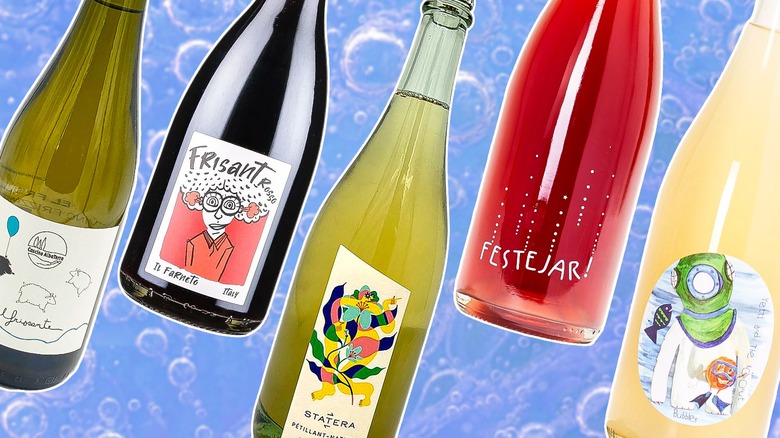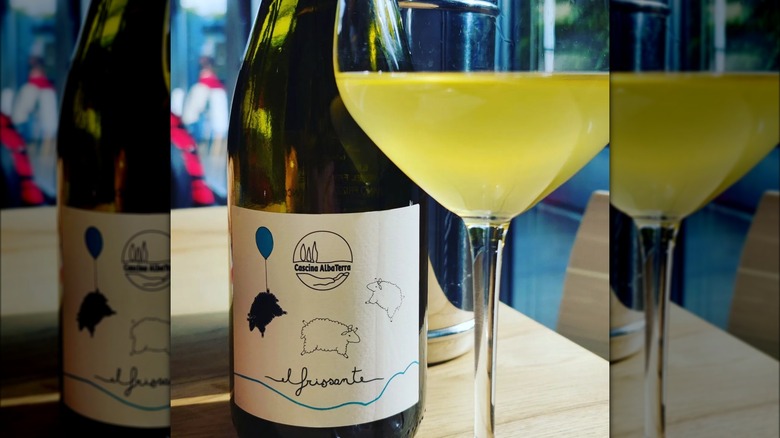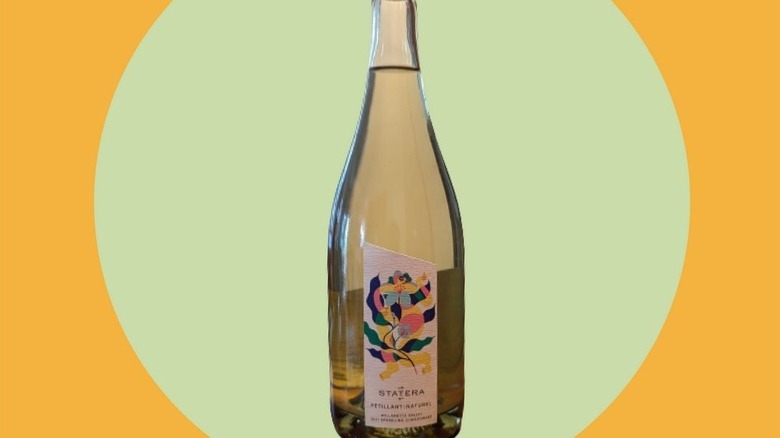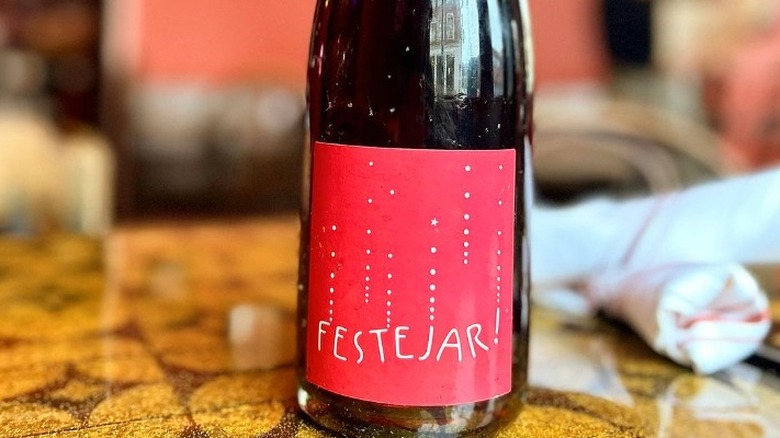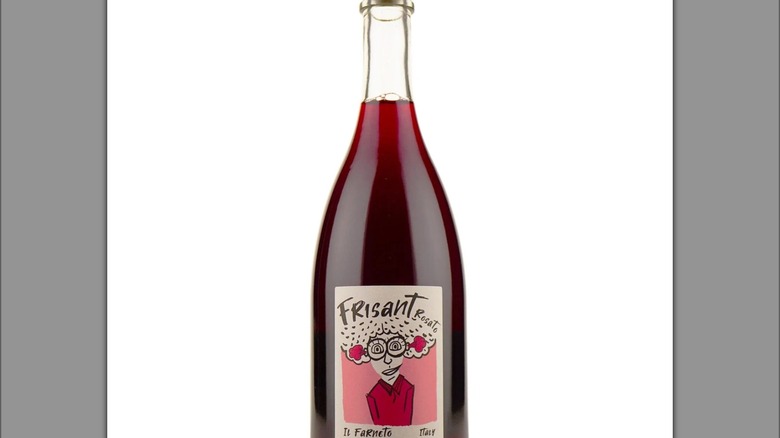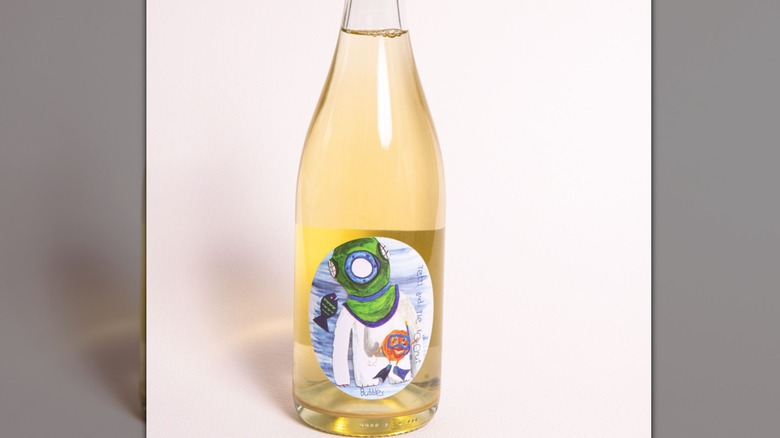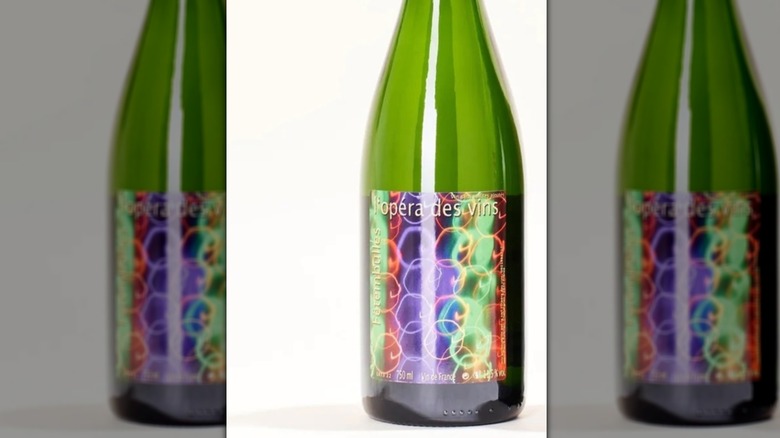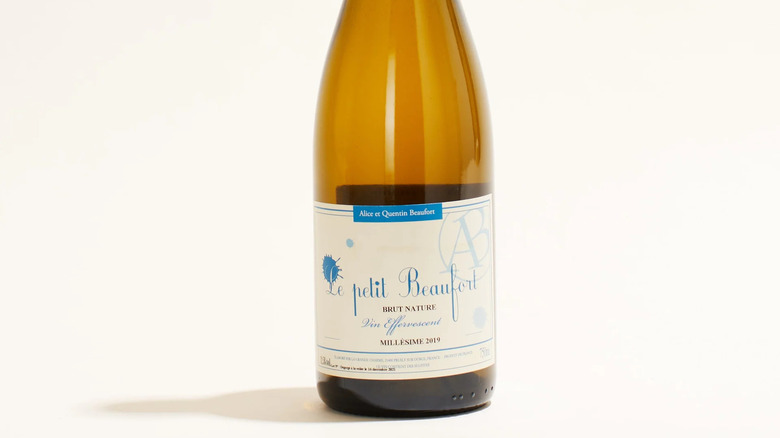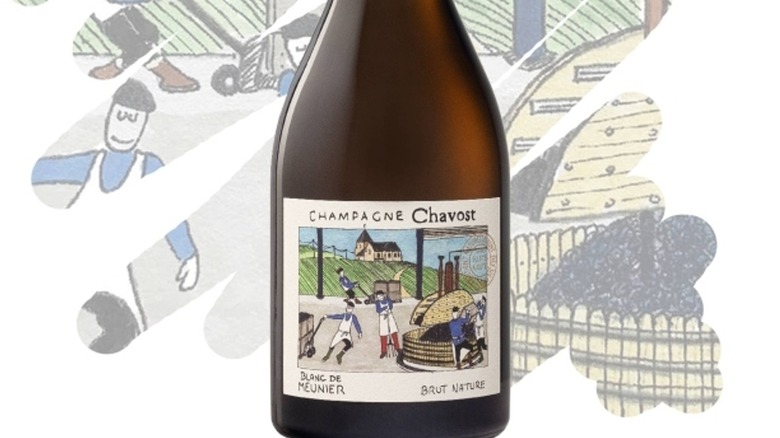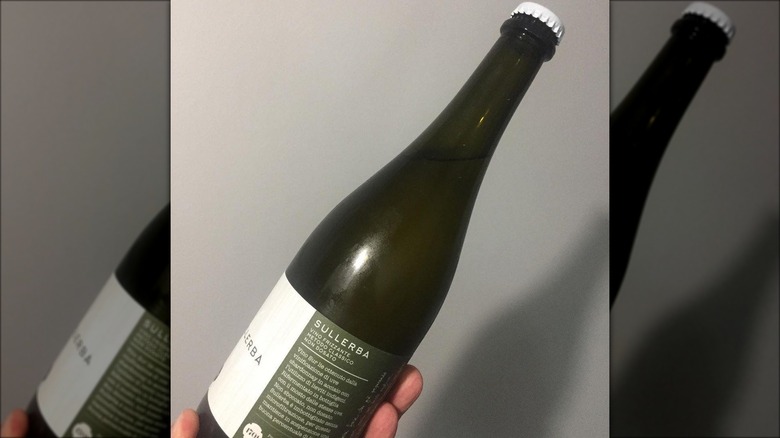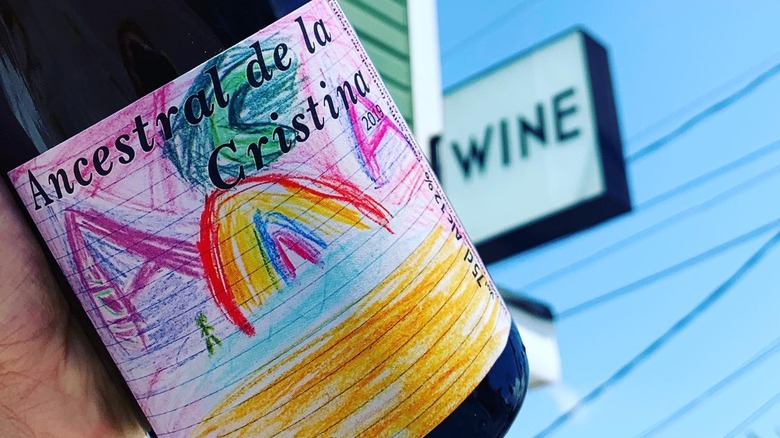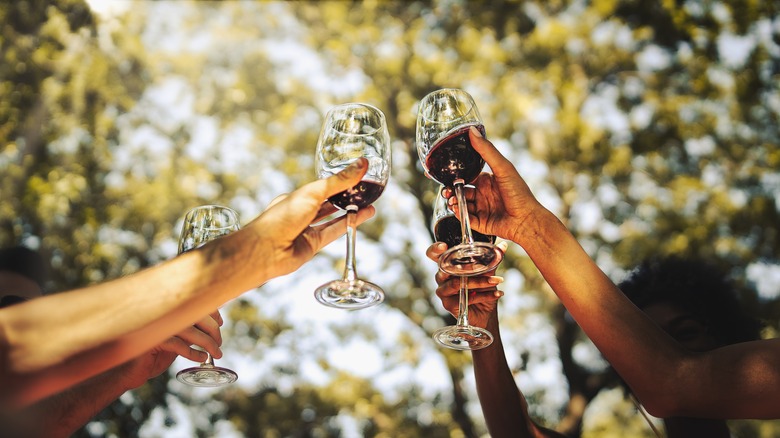10 Best Sparkling Wines To Drink In Spring, According To A Sommelier
It's giving spring! Finally. Personally, I'm ready for some lighter, brighter wines that vibe with the weather. As a sommelier, I taste and pair a lot of different wine styles, and one of my favorite ways to choose which bottle to drink is simply based on the weather. The warmer days, golden hour evenings, and doses of much-needed sunshine make me want to sip wines that are a bit more lighthearted in body. Enter bubbles. While there are plenty of austere Champagnes out there, I'm reaching for sparkling wines that lean a bit more playful.
These 10 sparkling wines pulsate with delicious notes of orchard fruits, florals, freshly baked sourdough, juicy and tart triple berry jam, and ripe strawberry and tarragon. Some are fizzy pét-nats that radiate on your tongue like the sunshine, while others are heavily saturated sparkling rosés that ease you out of your hibernation. All of the sparkling wines are approachable, somewhat whimsical, and easy to drink with or without food. They also all pair with so many of the flavors of spring, like the first spears of asparagus, little gem lettuces, and herby grilled chicken. So go on, dig out your sandals, and open one of these bottles to kick off the season.
Cascina AlbaTerra Il Frissante
Firstly, if you are a label shopper when it comes to wine, you're likely already sold. This cutie, from the Soave region in northern Italy, has hand-drawn, curly little sheep floating through the sky. Born out of the budding organic farm project, Cascina AlbaTerra isn't your average winery. Its mission is to build community through social empowerment, all while raising livestock, farming, and making delicious wine.
Il Frissante is a garganega pét-nat, an indigenous grape to the region that is relatively lean with good acidity and a refreshing salinity. The bubbles give it an extra kick of energy on the palate, bursting with notes of green pear, honeydew melon, kumquat, and lemon chiffon pie. It has a short skin maceration, giving it a textural edge and slight richness that both ground it and infuse a distinct characteristic of the wild. It's unfined and unfiltered, leaving it cloudy with lingering lees.
This is part of the wine's flavor and texture, so give it a gentle swirl to incorporate it before splashing it into your glass. At only 11.5% ABV, this is a great day-drinking wine for a sunny afternoon. It's light and refreshing, with a palate of freshly sliced citrus meets graham cracker crust. Drink sans food or pair it with classic potato chips, warm, marinated citrus olives, or barley charred asparagus with goat cheese and lemon zest.
Statera Pét-Nat Chardonnay
A partnership between winemaker friends Meredith Bell and Luke Wylde, Statera is a small label from the Willamette Valley in Oregon. The premise of the label is taking the well-known grape, chardonnay, and showcasing the diversity of personalities it can take on in the cool and willowy Pacific Northwest climate. The duo works with organic farmers to purchase fruit that is healthy and full of flavor, thanks to the holistic farming approach with the vines.
One result is this joyous pét-nat chardonnay. It's a faded dandelion color in the glass, with a distinct cloudy nature. Unfiltered, undisgorged, and without the addition of sulfites at bottling, this is a pure and vibrant representation of the grape that you do not want to miss. Fermented in neutral French oak barrels and poly totes, this is far from those toasted butter popcorn chardonnays from California that your aunt drinks. It's much fresher, with notes of pear, lemon drop candy, peaches and cream, citrus kombucha, and sea salt.
The minerality is reminiscent of wet stone, and the lees contact adds another dimension to the wine's overall profile, giving depth to the bubbles. Another wine that you can simply pair with sunshine alone; this is approachable, fun, and interesting all at once. I recommend sipping a glass of this while throwing vegetables on the grill, pairing it with burrata, peas, and mint, or drinking it alongside pasta.
Domaine La Boheme Festejar! Rosé
A dreamy shade of stewed rhubarb, Festejar! Rosé is straight-up electric. It's an unexpected wine from Auvergne, France, that checks all the spring wine boxes. Patrick Bouju of Domaine La Bohemeworks with the small plots of old vine gamay, syrah, and cabernet franc with horses, producing minimal intervention, natural wines that are a delight to drink. Festejar! Rosé is no exception.
This pét-nat is primarily gamay, giving way to notes of ripe cherry and strawberry with undertones of cranberry sauce and raspberry jam. The full fruit flavors of juicy and tart pair with warming notes of nutmeg and herbaceous hints of spearmint. The acidity isn't overly mouth-puckering but is more reminiscent of a sour red gummy bear, while the body is full (for a rosé) and everything you want it to be as a sip washes over your palate. Festejar! Rosé is kind of like the brambly hedge meets the beach.
The saturated bubbles have the energy to carry you right into spring and summer with pep while holding more weight than many sparkling wines. Its fuller body means you can easily pair it with heavier dishes like a seared pork chop, grilled salmon with green goddess sauce, or pavlova with the first strawberries of the season. It's vibrant and sparks a bit of curiosity while being easygoing, making it one of the best sparkling wines to drink in spring.
Il Farneto Frisant Rosato NV
Il Farneto is nestled in the rolling hills of Emilia-Romagna in Italy. The regional terroir is known for producing great fruit, from apples to blueberries to grapes. The vines at Il Farneto are certified biodynamic, and everything here is done by hand, from harvest through all stages of the winemaking process. In natural wine fashion, Il Farneto uses indigenous yeast and ages the wine in inert vessels, resulting in distinct and lively wines, such as this heavy sparkling rosé.
The pét-nat rosé is made from lambrusco. Yes, lambrusco. It had that bad reputation from the '70s as a sickly, sweet, sparkling red, but today's wine is a beautiful brambly red hue that will have you wondering if it's a red or rosé. With punchy strawberry, raspberry jam, watermelon, rhubarb, and violet, it's flavorful with zingy acidity. The bubbles are akin to berry pop rocks, somewhat delicate yet fizzy enough to feel refreshing. It's not sweet, just full of juicy red fruit that, when served cold, is an absolute delight to drink on the first warm days of spring.
This wine is super easygoing, and you can happily drink a glass or two while taking in the first blooms from your porch. Pairing this wine with a meal is easier than you might expect for a sparkling, almost red wine. Think about pasta or grain dishes with big chunks of Parmigiano Reggiano, caramelized leeks, and mushrooms.
Yetti and the Kokonut Bubbles Pét-Nat
About as bright as the Australian summer sun, Yetti and The Kokonut Bubbles Pét-Nat is a creation of the dynamic winemaking duo David Geyer and Koen Janssens. Working with numerous sustainable vineyards across southern Australia, the team, affectionately known as Yeti and the Kokonut, dive into their winemaking projects with an out-of-the-box perspective that produces some very fun-loving wines that are hard to put down.
Bubbles is a savagnin pét-nat from the Mclaren Vale. This is definitely a natural wine with more of a funky personality due to some slight volatile acidity. So, if that's your jam, this is a winner. If you are unsure but like sour beers, kombucha, Linenkugle's Summer Shandy (ahem, mom), or lemonade, you will likely also take to this wine. It's pumping with stone fruit, like peach and pear, along with citrus blossom, grapefruit zest, and honey, and has a hint of creamy funk on the nose, akin to goat cheese.
The bubbles fall into the effervescent range of medium, while the body is light to medium. When cold, it's mega refreshing on a warm day, making it one of the best sparkling wines to drink in spring. Try pairing this one with all things green, like grilled chicken with green tahini sauce and charred ramps, spinach or nettle risotto, or kale caesar.
Jean Pierre Robinot, L'Opera des Vins 'Fêtembulles'
If you haven't had a Jean Pierre Robinot yet, now is the time. An iconic French winemaker who set the standard for wine bars in Paris in the '80s, Robinot has since been making exceptional wines in the Loire Valley of France. Known for long fermentations, the winemaking process with Robinot takes on a long-term art form, as the wines are guided into existence without any interventions or additions of sulfur.
A traditionally made pétillant naturel, Fêtembulles is a compelling chenin blanc that will have you thinking in the best ways with each sip. Fermented in stainless steel, all of the beautiful aromatics of honeysuckle and apple skin are preserved. The bubbles on this one are absolutely zippy, perhaps Champagne-esque, giving way to notes of sharp green apple, juicy apricot, unripe pear, grapefruit peel, honey, chamomile, and toasted bread.
It's light in body and definitely has an ethereal quality to it that makes it a bit dreamy. The minerality is a chef's kiss, on point with Loire whites, bringing that babbling brook straight to your palate. It is honestly such a treat to enjoy and a vibe for those wispy pink clouds spring evenings grant us. A great pairing for Fêtembulles is a cheesy baked macaroni with Panko krispies on top, a round of oysters, or a creamy tarragon chicken pot pie.
Domaine Alice Beaufort Le Petit Beaufort
Domaine Alice Beaufort is a renowned winery in Burgundy that has been organically farming grapes for the last 50-plus years. More Champagne in character, the vineyard sits just across the appellation division from southern Champagne, and the family embraces the terroir, chardonnay, and pinot noir to the fullest, producing stunning wines like Le Petit Beaufort.
Made in the Méthode Champenoise or the Champagne method, the chardonnay grapes ferment for almost a year in neutral barrels before 30 months of aging. The wine is then bottled and aged on the lees for over two years. It's during this bottle aging phase that numerous transformations happen with the wine. The first is a second fermentation, capturing CO2 and becoming sparkling, and the second is the distinct biscuit and brioche notes it picks up from the extended aging on the spent yeast. This toasted almond is matched by baked apple, apricot, peach, a spike of ginger, and a bit of half and half.
The bubbles are tiny, elegant, and persistent, punching through from the bottom of your glass with exuberance. With racy acidity, the texture and fruit notes come into balance, giving the wine depth and edge. It's dry, sophisticated, and delicious. It's a great wine to pair with fried food, from fried chicken to falafel. And a delight alongside potato chips.
Champagne Chavost Blanc de Meunier Brut Nature
Chavost is a real stunner of estates, producing top-notch Champagne since they started back in 1946. Today, the vineyard is certified organic, and the team produces traditional wines from high-quality grapes without the addition of sulfites or other additives. The meunier is harvested by hand and fermented in stainless steel, preserving all of the delicate fruit and floral notes.
If you haven't had a grower Champagne before, I suggest you start with this one. It's a beautiful expression that plays really nicely into spring flavors with its bright and fresh personality. Classically crisp and mineral-driven, notes of ripe green pear, strawberry, apple, white peach, and a hint of lemon peel sing through. The fruit feels both juicy and rich, and a layered brioche and toasted almond characteristic give the wine the depth and texture you would expect in Champagne.
The bubbles are tiny and delightful, bursting on your palate with juicy acidity and leaving you with buttered toast and a chalky minerality. The acidity, bubbles, and body of the wine make it an inherent food wine that is easy to pair with many things you might be picking up from the first farmer's market in spring. Try it with an asparagus or mushroom quiche, soft and goopy young cheeses like brie, or a smash burger with shoestring fries.
1701 Franciacorta Sullerba, NV
Okay, I've just gotta say that not enough people are drinking Franciacorta. A real gem from Northern Italy, it often seems to be second thought to Italy's sweetheart, Prosecco, and unfairly compared to France's Champagne. But Franciacorta is an elegant beauty in its own right and deserves your attention, especially this one from 1701.
This 100% chardonnay is from the sunny hills of Lombardy. Organically grown on an old estate dating back to the 18th century, there is an unmistakable history to the wine. The grapes are hand-harvested and fermented in a clay amphora for nine months prior to the secondary fermentation, at which point the natural wine becomes sparkling. It's a saturated yellow hue, perfectly on point, with a spring color palette. The bubbles are Champagne-esque, tight, bright, and abundant. With notes of pink grapefruit, soft lime, green apple, and lemon, a glass is a breath of fresh air coming out of winter.
It has a savory, briny characteristic matched by a softer creaminess, which nicely balances the wine's acidity and body. This is such an approachable wine while still giving up some nuanced complexities (hello, Franciacorta). An easy splash of bubbles to drink without food, it can also be paired with numerous snacks or full-fledged meals. Try it with ricotta and pea pasta, grilled zucchini with chunks of Parmigiano Reggiano, lemon zest, and hazelnuts, or linguine alle vongole.
Jordi Llorens Ancestral de la Cristina
These Spanish bubbles from the Catalonia region of Spain are from Jordi Llorens, who has been making wine since 2008. With a long history of farming, Jordi starts his winemaking process with high-quality fruit that's both expressive of the terroir and the varietal. This pétillant naturel is old vine macabeo with just a few days of skin maceration.
Naturally fermented and unfiltered, the wine is slightly cloudy and packed full of flavor. It leads with juicy notes of peach, apricot, ripe pear, and a hint of quince. There is a pleasant and intriguing complexity brought to the fruit that's both structured and bright. Yellow flower, honeycomb, Italian almond cake, and coriander are present and give this wine such character you won't want to put it down. The fizz is so refreshing and textured that it's made for spring drinking.
With good acidity, the wine is easy to pair. Couscous salad with roasted almonds, oranges, and basil would be a great match for this wine. Seared cod with a green fruit salsa of pear, granny smith apple, ginger, and cilantro would also pair beautifully. It's a wine that offers up something new with each sip, not unlike each unfolding day of spring.
Methodology
With all the different sparkling wines out there, it's hard to narrow it down to just 10, but I think this mix of yeasty pet nats, Champagne, and saturated rosé bubbles ease you out of the colder weather and heavier wines into lighter, brighter days. For this list, I chose wines that have a lightheartedness to them. They are easy to drink, yet still spark curiosity or offer some complexities to unpack.
I think these are 10 of the best sparkling wines to drink in spring because they are fresher, lighter, lower ABV wines that are playful, diverse, and compelling. Even though they are all so different, each wine is approachable and a delight to drink. I considered pairings and stand-alone glasses. For me, I almost always want a glass to be enjoyable with or without food, and these check those boxes. They can go seamlessly from a porch afternoon sans food to a patio dinner, pairing well with seasonal produce and foods we often crave as the weather warms up. To me, these wines embody spring sunshine and expose a bit of skin to the world again, each a joy to drink.
